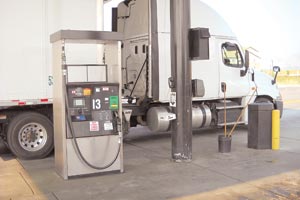Senior Reporter
Diesel Jumps 6.4¢ to $2.556;Gasoline Rises 1.9¢ to $2.337

The average price of diesel fuel in the United States rose 6.4 cents a gallon to $2.556, the largest increase in more than two years, the Department of Energy reported.
It was the steepest climb since Sept. 2, 2013, when the price rose 6.8 cents.
The rise in the cost of diesel follows a 1.6-cent increase the prior week, DOE said Oct. 13.
And the national average price for trucking’s main fuel was cheaper by $1.142 a gallon from a year ago, the DOE’s Energy Information Administration said after its weekly survey of fueling stations.
Retail diesel prices rose slightly in all 10 regions of the country, but the increase was 14.5 cents in the Midwest.
“The U.S. average went up 6 cents, and you have to understand that the U.S. average is all the different regions together. So when you have one region going up 15 cents and the rest of them go up 2 cents or 3 cents, it makes it look a lot larger than it really is. This week is really a story about the Midwest, rather than anything going up nationally,” EIA analyst Mason Hamilton said.
Meanwhile, the average national price of gasoline rose 1.9 cents to $2.337 a gallon. However, in the Rocky Mountains, gas prices fell by 5.3 cents, but they rose by 5.3 cents in the Midwest and 3.9 cents in the lower Atlantic.
Hamilton attributed the sharp rise in diesel to a combination of factors that is influencing supply and demand.
“Right now, there’s a lot of refinery maintenance going on in the Midwest, so a lot of refineries have lower production or are offline for maintenance,” Hamilton said. “There’s also the gearing up of the harvest season. So a lot of the tractors and trucks are up and running and consuming diesel as part of the harvest.”
Roy Butler, service manager for Duffield Hauling Inc. in King George, Virginia, said his carrier keeps its fuel costs in check through preventive maintenance.
Duffield has 50 tractors that haul mostly dump trailers and liquid tankers on two- to three-hour runs.
“When everything’s not meshing correctly in your truck, then it uses more fuel,” Butler said.
“Preventive maintenance is the biggest thing, from your servicing of your trucks to the air pressure in your tires,” he said. “People don’t think it’s a big amount, but it’s huge.”
Butler said that he uses synthetic fluids in Duffield’s truck transmissions and rear ends. “Both of those give you better fuel mileage,” he said. “It’s been working for us for years.”
Drivers conscious about fuel efficiency also are important, Butler said. “Do you have a driver who keeps his foot to the floor or one that is more consistent, stays at one speed when he’s on the highway? It’s getting harder and harder by the day to find those drivers.”
He also puts fuel additives in the company’s trucks year-round.
Western Transport, based in Idaho Falls, Idaho, buys fuel in bulk and has contracts with large fuel stops to keep the company’s 60 power units and 85 refrigerated and dry vans on the run, said Adam Hanson, Western’s operations manager.
But Western also has installed trailer skirts and wide-base tires on most of its trucks since 2008.
“It’s a no-brainer — anything we can do to keep fuel costs down,” Hanson said.
But he also believes that drivers are a key to squeezing the most out of each fuel dollar.
“We’re constantly coaching our guys on how to get better fuel economy,” Hanson said. “We incentivize. We have bonus incentives that we put out there. It’s about making the driver aware of his behavior and explaining how it can have consequences.”
West Texas Intermediate crude for November delivery declined by $3.25 since Oct. 9 to settle at $46.38 a barrel Oct. 15 on the New York Mercantile Exchange. The International Energy Agency expected that a global crude glut will continue into 2016.
IEA said global oil demand will revert to long-term trend levels of 1.2 million barrels a day in 2016, down from 1.8 million this year, amid a softer economic outlook for oil exporters.
Total supply from nations outside OPEC will decline by 500,000 barrels a day next year, which IEA said last month was the steepest drop since 1992. U.S. oil output will fall to 12.56 million barrels a day in 2016, from 12.75 million this year, Bloomberg News reported.
OPEC projected U.S. output to shrink in 2016 for the first time in eight years, according to Bloomberg News.




